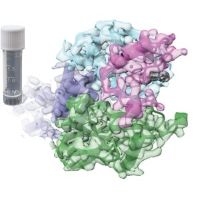Specification
| Description | Recombinant protein from the full-length sequence of Homo sapiens ring finger protein 11 (RNF11) (NM_014372). |
| Organism | Homo sapiens (Human) |
| Expression Host | Human Cells |
| Tag Info | His or DYKDDDDK. Please contact us if you need further information or require specific designed tag. |
| Purity | Greater than 90% by SDS-PAGE gel |
| Uniprot ID | Q9Y3C5 |
| Entry Name | RNF11_HUMAN |
| Gene Names | RNF11 CGI-123 |
| Alternative Gene Names | |
| Alternative Protein Names | RING finger protein 11 |
| Application | Antigens, Western, ELISA and other in vitro binding or in vivo functional assays, and protein-protein interaction studies; For research & development use only! |
| Buffer | Purified protein formulated in a sterile solution of PBS buffer, pH7.2, without any preservatives |
| Endotoxin | Endotoxin level is < 0.1 ng/µg of protein (<1EU /µg) |
| Length | 154 |
| Molecular Weight(Da) | 17444 |
| Protein Sequence | (The sequence of expressed protein may have some variation from the sequence shown below. Please contact us for the exact sequence.) MGNCLKSPTSDDISLLHESQSDRASFGEGTEPDQEPPPPYQEQVPVPVYHPTPSQTRLATQLTEEEQIRIAQRIGLIQHLPKGVYDPGRDGSEKKIRECVICMMDFVYGDPIRFLPCMHIYHLDCIDDWLMRSFTCPSCMEPVDAALLSSYETN |
Background
| Function | FUNCTION: Essential component of a ubiquitin-editing protein complex, comprising also TNFAIP3, ITCH and TAX1BP1, that ensures the transient nature of inflammatory signaling pathways. Promotes the association of TNFAIP3 to RIPK1 after TNF stimulation. TNFAIP3 deubiquitinates 'Lys-63' polyubiquitin chains on RIPK1 and catalyzes the formation of 'Lys-48'-polyubiquitin chains. This leads to RIPK1 proteasomal degradation and consequently termination of the TNF- or LPS-mediated activation of NF-kappa-B. Recruits STAMBP to the E3 ubiquitin-ligase SMURF2 for ubiquitination, leading to its degradation by the 26S proteasome. {ECO:0000269|PubMed:14755250}. |
| Pathway | |
| Protein Families | |
| Tissue Specificity | Expressed at low levels in the lung, liver, kidney, pancreas, spleen, prostate, thymus, ovary, small intestine, colon, and peripheral blood lymphocytes, and, at intermediate levels, in the testis, heart, brain and placenta. Highest expression in the skeletal muscle. In the brain, expressed at different levels in several regions: high levels in the amygdala, moderate in the hippocampus and thalamus, low in the caudate and extremely low levels in the corpus callosum (at protein level). Restricted to neurons, enriched in somatodendritic compartments and excluded from white matter (at protein level). In substantia nigra, present in cell bodies and processes of dopaminergic and nondopaminergic cells (at protein level). In Parkinson disease, sequestered in Lewy bodies and neurites. Overexpressed in breast cancer cells, but not detected in the surrounding stroma and weakly, if at all, in normal breast epithelial cells (at protein level). Also expressed in several tumor cell lines. {ECO:0000269|PubMed:14559117, ECO:0000269|PubMed:14562029, ECO:0000269|PubMed:17917589}. |
QC Data
| Note | Please contact us for QC Data |
| Product Image (Reference Only) |  |

